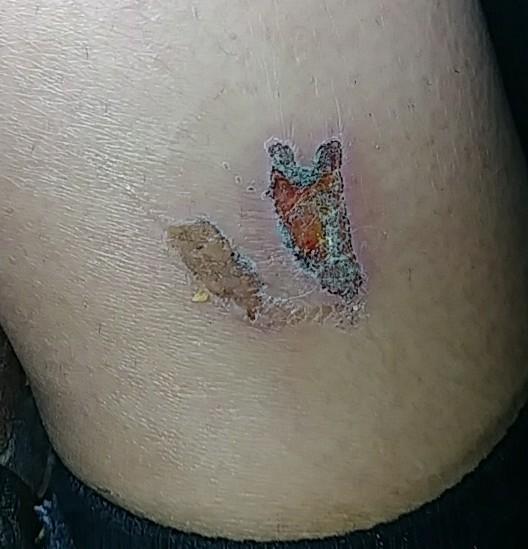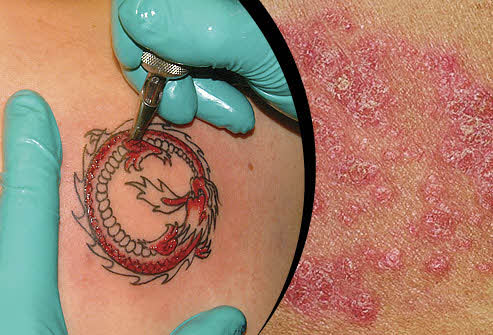

The lesion was asymptomatic (one man), non-tender (one man), or painful (one man). The tattoo was dark (either black or blue) and often presented as papules (three men) or nodules (two men) that were either individual or multiple and intact or ulcerated.

The onset of infection after tattoo inoculation was either within less than one month (two men), three months (two men), or 69 months (one man). Tattoo-associated systemic fungal infection has been reported in six patients: five men and one patient whose age, sex, immune status, and some tattoo features (duration, color, and treatment) were not reported. Treatment with topical and/or oral antifungal agents provided complete resolution of the dermatophyte for all the patients with tattoo-associated tinea. Tattoo ink-related phenomenon (presence of nanoparticles, polycyclic aromatic hydrocarbons, and cytokine-enhancement) and/or the creation of an immunocompromised cutaneous district are potential causes of late tinea infection.
Black ink infected tattoo skin#
Injury to the skin from the tattoo needle, or use of non-sterile instruments, or contaminated ink, and/or contact with a human or animal dermatophyte source are possible causes of early tinea infection. Tinea appeared either early (within one month or less after inoculation during tattoo healing) in six patients or later (more than two months post-inoculation in a healed tattoo) in six patients. Three patients presented with tinea incognito resulting from prior corticosteroid treatment. The cultured dermatophytes included Trichophyton rubrum, Epidermophyton floccosum, Microsporum canis, Microsporum gypseum, and Trichophyton tonsurans. Several sources for the tinea were documented: autoinfection (two patients), anthrophilic (tinea capitis from the patient’s son), and zoophilic (either the patient’s cat or dog).

The diagnosis was established either by skin biopsy, fungal culture, and/or potassium hydroxide preparation. Tattoo-associated tinea typically occurred on an extremity in the black ink. Tattoo-associated tinea corporis has been observed in 12 individuals with 13 tattoos this includes the 18-year-old man who developed a dermatophyte infection, restricted to the black ink, less than one-month after tattoo inoculation on his left arm described in this report. The PubMed search engine, accessing the MEDLINE database, was used to search for all papers with the terms: (1) tinea and tattoo, and (2) systemic fungal infection and tattoo. These include not only dermatophyte infections (tattoo-associated tinea) but also systemic mycoses (tattoo-associated systemic fungal infections). " Per TMZ, Alex "claims someone connected with production handed her a drink that contained a 'date rape drug' and it completely messed her up." That case was dismissed in 2015.Fungal infections may occur within tattoos. in which Alex appears extremely intoxicated and throws herself at. According to TMZ, the suit was filed "over a party episode that was shot in 2012 ("Mixxxy Madness"). In 2014, the show was sued by Alexandra "Alex" Estevez, the shop's former receptionist, who claimed she quit after she was roofied for ratings. Another lawsuit over an allegedly infected tattoo was dismissed in 2016 "because the woman had signed a waiver releasing the parlor from liability," per Reuters. According to TMZ, the fight's licensing company was seeking "more than $100,000 in damages."Īlso in 2018, Ceaser's legal team had to deal with a customer seeking half a million dollars for an allegedly infected tattoo. Earlier that year, Ceaser was sued for allegedly pirating a Pay-Per-View boxing match and broadcasting it at his shop.


 0 kommentar(er)
0 kommentar(er)
